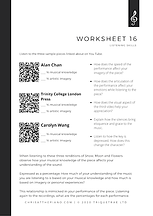
Chris at the Piano
Chris Caton-Greasley LLCM(TD) MA (Mus)(Open)
Composer, Ethnographic Musicologist, Public Speaker, Researcher & Teacher
6. Conclusion
Whilst an educator is perfectly capable of teaching pieces that they, personally, have not played, it has become more evident that familiarity with a piece grants a far more comprehensive method of teaching and that the learner understands that the educator not only can teach but can also ‘do’ (perform) as well.
Musical analysis grants the performer a deeper understanding of the composer's unwritten expectations, this in turn enables the performer to decide whether to showcase a personal interpretation or a translation within the constraints of the musical score, era and composer.
From an educator’s perspective musical analysis widens the learning objectives of the piece to include period, social, economic, political and environmental viewpoints. Comparative analysis enables an educator to select a varied repertoire of pieces based on more substantial reasons than “My learner will enjoy this” allowing it to become “My learner will enjoy this and benefit from it because of these new skills and the improvement of already known skills”. In short, comparative musical analysis allows an educator to guide learning down a logical path which is of benefit and enjoyment to the learner.
Comparative analysis, from an educators perspective, must not be confined to the printed score alone. The internet provides access to many translations of a piece of music, some good and some less good, but all useful. By using the video and audio platforms available a comparative analysis sheet can be compiled for a student, see Appendix 1, to guide the listening skills. In this way the performer grants the educator access to many styles of translation to discuss with learners. This does not negate the requirement for the educator to be able to indicate, model and discuss the piece's qualities and inconsistencies. The combined analyses of written score and performance will enable prompt cards to be created with the summaries of each requirement included. (See Appendix 2 for my personal examples). Using this alongside a learner’s book and video demonstrations [2], available on my website[3], the performer and educator can work together to enable the learner to become a confident and accomplished pianist and performer.
Video Demonstration


